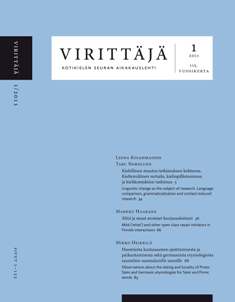Kielellinen muutos tutkimuksen kohteena. Kieltenvälinen vertailu, kieliopillistuminen ja kielikontaktien tutkimus [Linguistic change as the subject of research. Language comparison, grammaticalisation and contact-induced research]
Abstrakti
Tämä kirjoitus pohtii kielellisen muutoksen tutkimusmenetelmiä kahden tapaustutkimuksen avulla. Tarkasteltavina ilmiöinä on numeraalin yksi kehittyminen artikkeliksi ja spatiaalisen postposition perään muuttuminen rektiosuhteen ilmaisimeksi. Molempia ilmiötä on tähän saakka pidetty kielikontaktin virittäminä muutoksina. Eri-ikäisiin kirja- ja puhekielen aineistoihin perustuvat tapaustutkimukset osoittavat, kuinka kieliopillistumisen, kielikontaktien ja kieltenvälisen vertailun näkökulmia yhdistelemällä on mahdollista avata uusia ikkunoita kielenmuutoksen tutkimukseen.
Kieliopillistumistutkimuksen näkökulmasta numeraalin kehittyminen indefiniittipronominiksi ja artikkeliksi sekä spatiaalisen adposition kehittyminen rektioadpositioksi ovat kielissä tavallisia ja kognitiivisesti luontevia muutoksia. Suomessakaan ei ole siten syytä sulkea pois mahdollisuutta, että yksi olisi voinut lähteä kehittymään artikkeliksi ja perään rektion merkitsijäksi itsenäisesti ilman muiden kielten vaikutusta. Kielensisäinen muutos voi kuitenkin kietoutua ulkoisiin tekijöihin. Tätä on korostettu kielitypologisesti orientoituneen kieliopillistumistutkimuksen lisäksi erityisesti kontaktilingvistiikassa, jossa muutoksen syiden jakoa kielensisäisiin ja kielenulkoisiin ei ole koskaan pidetty selkeänä. Sen sijaan tutkijat korostavat muutoksen monilähtöisyyden mahdollisuutta, joka käy ilmi myös käsiteltävistä tapaustutkimuksista: sekä artikkelin yksi että rektion indikaattorin perään kehityksessä kontakti on voinut vahvistaa kielen omaa kehitystä. Kieltenvälinen vertailu – typologinen tai kahta tai useampaa kieltä koskeva – taas mahdollistaa kehityksen suunnan ennustamisen: ei ole harvinaista, että sama ilmiö edustaa eri kielissä eri kehitysvaihetta, ja kieliä vertailemalla voidaan ennustaa varhaisemmassa vaiheessa olevan kielen kehityksen todennäköistä suuntaa.
Yksi ja perään osoittavat, että suomen kirjakielen historiassa kielenmuutoksen ulkoisia ja sisäisiä syitä ei ole välttämättä mahdollista suodattaa erilleen. Oman ja vieraan erottaminen ei aina ole niinkään kielellinen kuin kieli-ideologinen kysymys.
---
Abstract
This article examines the methodological possibilities of approaching linguistic change with reference to two individual case studies in Finnish. The first case study concerns the development of the numeral yksi (‘one’) to its use as an indefinite article, and the second concentrates on the development of the spatial postposition perään (‘behind/after’) into a marker of grammatical relations. Until now, it has been claimed that both phenomena are induced by language contact. Both case studies exploit data from various stages of written and spoken Finnish, and they show that by combining the perspectives of grammaticalisation, contact-induced change and cross-linguistic comparison, it is possible to open up new insights into the research of language change.
From the point of view of grammaticalisation, the development of a numeral into an indefinite pronoun and article, or of a spatial adposition into a marker of grammatical relations, is an ordinary and cognitively natural linguistic change. Even in the case of Finnish, there is no reason to contend the possibility that these developments may indeed have taken place without the influence of other languages. However, changes within any given language are often linked to a variety of external factors. In addition to typologically oriented research on grammaticalisation, this fact has been extensively documented in the field of contact linguistics, where the strict division between internal and external causes has been questioned. Many researchers in fact stress the possibility of multiple causation in linguistic change, a fact that becomes clear from the case studies examined in this article as well: in the case both of the article yksi (‘one’) and of the postposition perään (‘behind/after’) contact with other languages may well have accelerated changes already occurring within the language. Cross-linguistic comparison, in turn – whether typological or a comparison between two or more languages – makes it possible to predict the direction of change: it is not unusual that the same phenomenon represents different stages of development in different languages, and by comparing languages with one another we can foresee the probable direction the language at an earlier stage of development will take.
The cases of yksi (‘one’) and perään (‘behind/after’) demonstrate that it is not necessarily possible to separate external and internal causes of linguistic change in the history of written Finnish. The domestic and the foreign may have intertwined, and discerning them from one another is often not a question of linguistic structure but one of language ideology.






